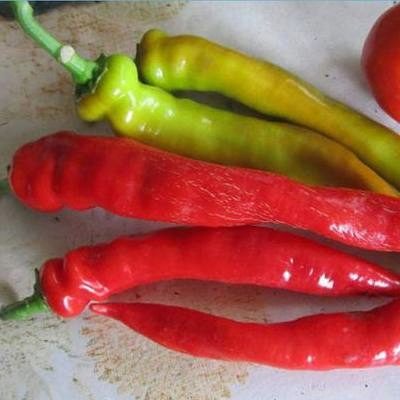
- Authors: folk selection
- Bush height, cm: 60-80
- Growth type: medium-sized
- Fruit shape: conical elongated
- Fruit color: bottle green in technical ripeness, dark red in full
- Ripening terms: mid-season
- Fruit size, cm: length up to 13
- Yield: high
- Appointment: for fresh consumption, for canning, for freezing
- Growing conditions: greenhouse, open ground
Tsitsak is a popular hybrid variety of bell pepper. The variety belongs to the spicy species and has both advantages and disadvantages. Let's take a closer look at the features of this vegetable.
Description of the variety
Among the advantages of the presented variety, it is worth noting its high yield, as well as strong immunity to diseases and unpretentious care. The disadvantages include its excessive love for light and warmth, therefore, suitable regions for its cultivation are Georgia and Armenia. However, in the southern regions of Russia, pepper will also grow without problems in the open field, but in more severe climatic conditions, it should be planted in a greenhouse.
Characteristics of the appearance of plants and fruits
The bush has an average vigor of growth, it reaches a height of 60-80 cm and has green, oblong, elongated leaves. The main stem is quite strong, the foliage is medium. The fruits are formed in the form of an elongated cone 13 cm long, in technical ripeness they have a green skin, in full - dark red.
Purpose and taste
The fruit tastes spicy, moderately sweet, the level of pungency is 1500-3500 SHU. Fans of spicy dishes are happy to add fresh vegetables to salads and hot dishes, and connoisseurs of a calmer taste canned Tsitsak pepper. This variety also tolerates freezing well.
Ripening terms
Fruiting begins about 100-110 days after the first shoots hatch, so the variety can be classified as a crop variety with a mid-ripening period.
Yield
This is a high-yielding variety that can please the gardener with vegetables in the amount of 2-4 kg per square meter. It is allowed to remove the fruits both at the stage of technical maturity, when they are still light green in color, and already bright red ripe peppers.
Landing scheme
Sowing is carried out in February-March, a more specific period depends on the climatic conditions where the plant will be cultivated. To germinate seeds, they are placed in a damp cloth for a week, and then sown to a depth of 0.5 cm in containers with a nutrient substrate and moistened. Next, the container is covered with foil, and seedlings are waiting for seedlings to emerge. When the first sprouts appear, the container can be placed on the windowsill, and the film can be removed.
Young seedlings need complex feeding and moderate irrigation; at the stage of the appearance of the first leaves, the bushes are planted in separate containers. About a week before transplanting to the summer cottage, the shoots need to be hardened, that is, put them outside, and every day the time spent in the fresh air should be increased.
The bushes are transplanted onto a bed previously mulched with grass and sawdust - thus the gardener will make it easier for himself to care for the vegetable, namely: he will no longer need to regularly loosen it. The presented variety can be planted according to the 50x50 cm scheme or in rows of 25x50 cm.

To get a large and tasty harvest of pepper, you need to take care of the seedlings in advance. When growing pepper seedlings, you need to correctly determine the sowing time, pre-sowing seed treatment, prepare the necessary container and soil.
Growing and care
When caring for a plant, special attention should be paid to watering and feeding. So, the culture needs moisture 2-3 times a week. For watering, use warm, settled water, and irrigate the ridge in the morning or evening. It is customary to use about 0.7 liters of water for each square meter.
Before the formation of flowers, the plant is fertilized with nitrogen compounds, and then with mixtures containing phosphorus and potassium. If at the planting stage the land was not mulched, then it is necessary to regularly loosen the soil and remove weeds.

To harvest a tasty and rich harvest of pepper, you need to comply with all the conditions of agricultural technology, and proper care begins with planting plants. Before planting pepper in open ground, it should be prepared. It is also important to take care of the seedlings and planting space in advance.




For good growth of pepper bushes and active fruiting, you need to regularly apply mineral and organic fertilizing to the soil. It is necessary not only to choose the right formulations, but also to use them at the right stage in the development of culture. The frequency of top dressing is always individual. It depends directly on the composition of the land on your site. The poorer the soil composition, the more often you will need to feed the pepper.
Disease and pest resistance
The hybrid is highly resistant to disease and insect damage, however, if the rules of agricultural technology are not followed, it can still become a victim of pests, for example, aphids, spider mites, slugs. To prevent this problem, you should observe the irrigation regime, avoid waterlogging of the soil or, conversely, the formation of a hard crust. Keep the area clean, regularly inspect the planting for the presence of parasites and their larvae, loosen the soil and remove weeds.

Pepper is one of the most common vegetables in home gardens. This culture is quite stable and unpretentious. However, under certain conditions, this plant can suffer from infections and harmful insects. Before treating peppers for diseases or pests, you need to find out the cause of the problem, otherwise the treatment may be ineffective.





















































































